The SanDisk X400 1TB SSD Review
by Billy Tallis on May 6, 2016 9:00 AM ESTMixed Random Read/Write Performance
The mixed random I/O benchmark starts with a pure read test and gradually increases the proportion of writes, finishing with pure writes. The queue depth is 3 for the entire test and each subtest lasts for 3 minutes, for a total test duration of 18 minutes. As with the pure random write test, this test is restricted to a 16GB span of the drive, which is empty save for the 16GB test file.
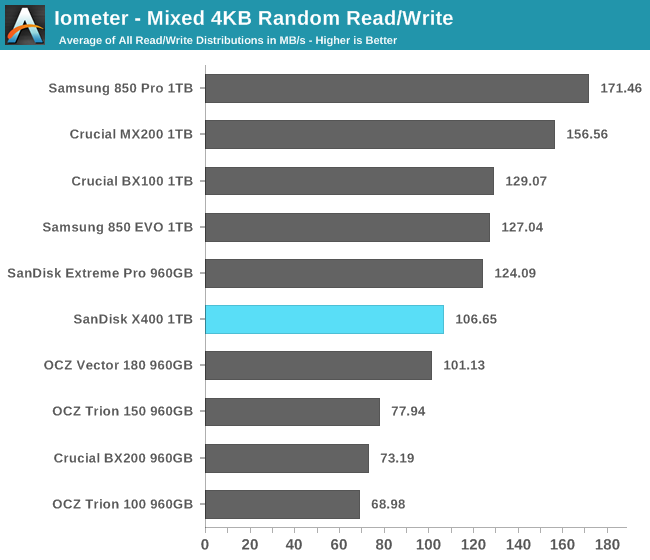
The mixed random I/O performance of the X400 is in the middle of the pack, slightly ahead of the MLC-based OCZ Vector 180 and significantly faster than the other three planar TLC drives.
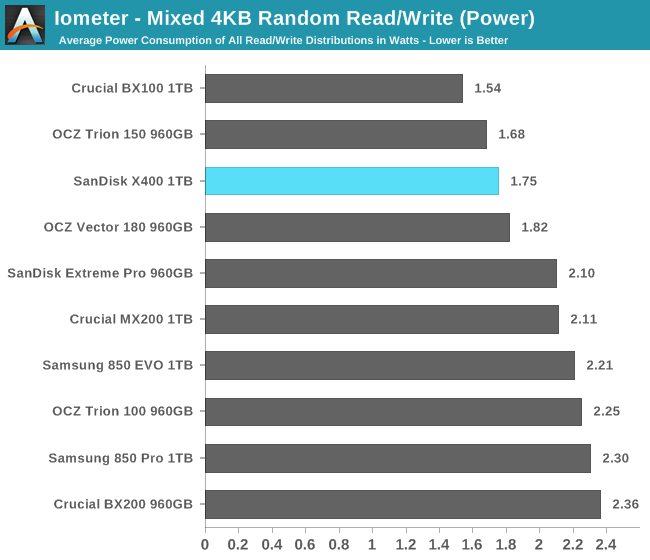
The X400 is once again the most power efficient planar TLC drive by a wide margin, and also ahead of a few of the MLC drives.
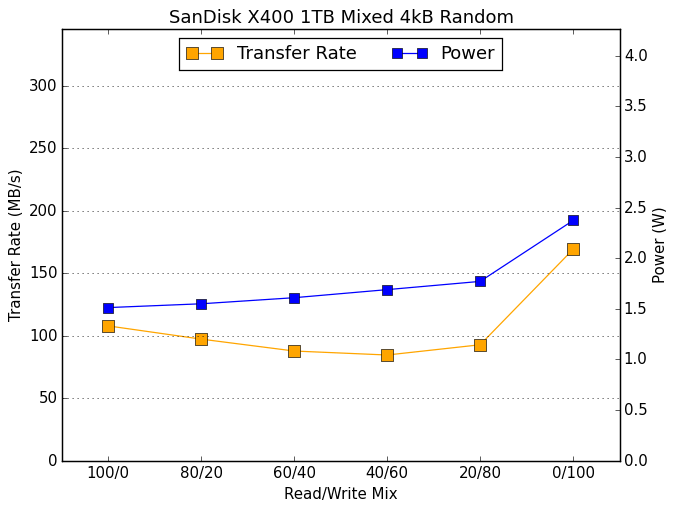 |
|||||||||
As the proportion of writes increases, the X400's power consumption grows quite slowly. Performance does suffer in the middle of the test and the spike at the end when the test shifts to pure writes is smaller than for the MLC drives and the 850 EVO.
Mixed Sequential Read/Write Performance
The mixed sequential access test covers the entire span of the drive and uses a queue depth of one. It starts with a pure read test and gradually increases the proportion of writes, finishing with pure writes. Each subtest lasts for 3 minutes, for a total test duration of 18 minutes. The drive is filled before the test starts.
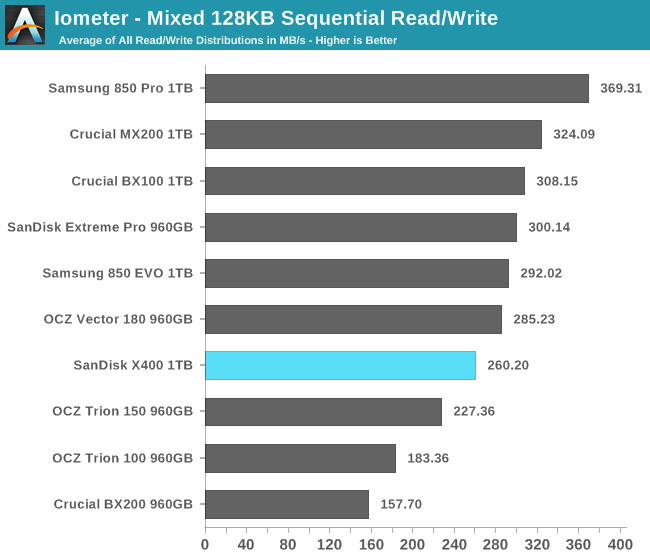
The mixed sequential I/O performance of the SanDisk X400 is not able to match any of the MLC drives, but is still comfortably ahead of the other planar TLC drives.
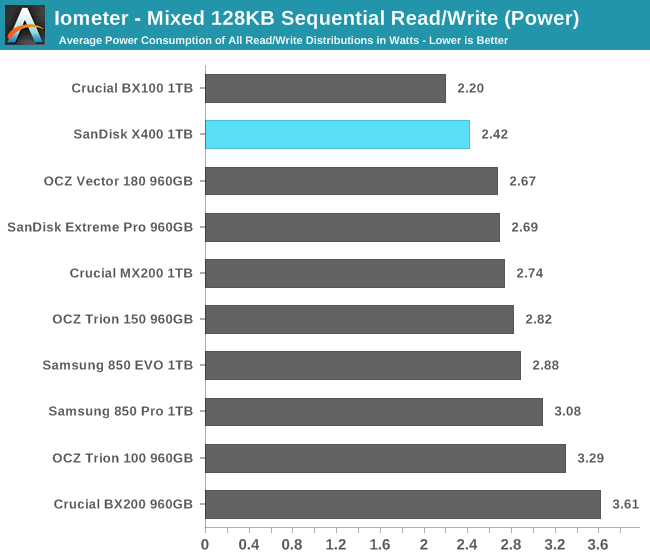
Average power consumption on the mixed sequential test is lower than everything other than the Crucial BX100, and the SanDisk X400 manages to tie the Vector 180 for efficiency, but otherwise it stands above only the other planar TLC drives.
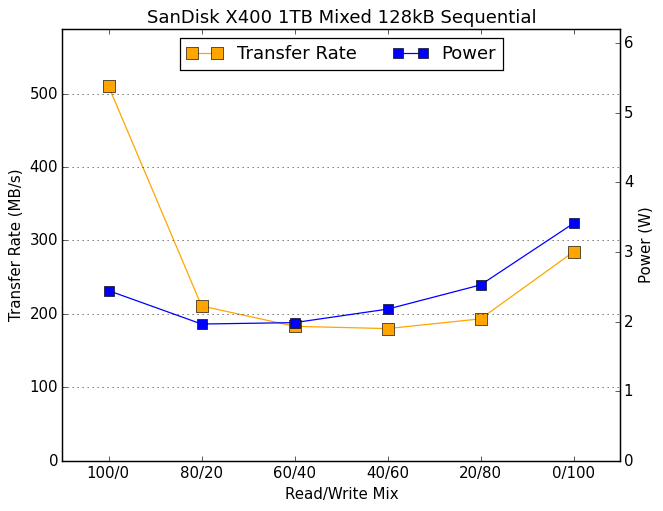 |
|||||||||
The performance and power curves for the SanDisk X400 are very similar to the SanDisk Extreme Pro except in the pure-write phase at the end of the test, where the X400's performance cannot come close to any of the MLC drives. The X400 beats the OCZ Trion 150 overall because its high read speed outweighs the write speed advantage of the Trion 150.










41 Comments
View All Comments
Margalus - Friday, May 6, 2016 - link
It uses less power than some, and is priced lower. But it seems performance is severely lacking..jabber - Friday, May 6, 2016 - link
This just shows what a fantastic budget SSD the BX100 was. Crucial were stupid to dump it.Mixal11 - Sunday, May 8, 2016 - link
Exactly, for me it's v300 for low end desktop, BX100 for laptops (hard to get over time) and Sandisk Extreme Pro or 850 Pro for high end. I avoid TLC, because of experience with Dell Samsung 841oem. Who knows if I can read data from it after year or two. TLC drives are great to reduce ssd prices.jabber - Sunday, May 8, 2016 - link
Yeah everyone moaned about the V300's back in the day but they are perfect SSDs for putting in SATA II kit as they push 285+MBps all day long...plus they are the cheapest you can buy usually. Also I have bought dozens of them and not one has yet failed. They are a solid tough little SSD. I shall be sorry when they go.jhh - Friday, May 6, 2016 - link
I wonder if they have included any of the increased endurance technology from their Smart Storage (formerly part of Smart Modular) acquisition. The idea behind the technology was that most cells didn't need full current to program, and when programmed with less than full current, that the cell would allow more write/erase cycles.Michael Bay - Friday, May 6, 2016 - link
Goddamn it, one more terabyte.Just one.
Samus - Friday, May 6, 2016 - link
I think if I were shopping for a TLC drive I'd stick with Sandisk too. I haven't had any issues with their Ultra II's, although many people have. I have, however, had two ADATA SP550's fail (a 120GB and 240GB) one during a power failure in a laptop (BSOD) which a secure erase recovered usability of the drive, and another within an hour of installation - cloning about 100GB of data to it killed it an no longer detects by BIOS.I have 5 or so other SP550's in the field running fine though, but none of them have suffered the "abuse" of the above cases.
I have dozens of Mushkin drives out there, even ECO2's, all running incredibly well. I have a few ECO3 TLC drives in house about to go out, but I've been avoiding them because the ECO2 is still available.
On a side note, I still have 840EVO's coming in at least bi-weekly with basically unusable performance. Samsung is hell to deal with for RMA (a stark contrast to, say, OCZ that actually sends you an advanced replacement!) and nothing I can do revives performance in these drives. Secure erase, fill and trim, etc, nothing works. Even after a fresh OS install they read at half the speed they write. It's crazy, slower than a 2.5" hard disk.
ladder_to_heaven - Friday, May 6, 2016 - link
Win 8.1 - STILL? -For the love of god WHY?
Billy Tallis - Friday, May 6, 2016 - link
Switching to Windows 10 would require re-testing a lot of drives, monopolizing the testbed for a month. It'll probably happen at some point this year, but I'll need to put together a second system for it (hopefully a Skylake system with working PCIe power management).jabber - Saturday, May 7, 2016 - link
Yeah no rush, after all 85% of 10's code is...8.1.